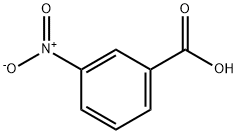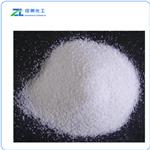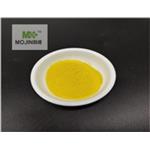Chemical Properties
White or light yellow monoclinic leaf-like crystal. Soluble in acetone, chloroform, ethanol and ether, slightly soluble in benzene, water, carbon disulfide and petroleum ether, more soluble in hot water. It smells like almonds. 3-nitrobenzoic acid is quite a strong acid, it is soluble in a relatively weak base. It is about ten times more acidic than benzoic acid.The conjugate base of benzoic acid is stabilised by the presence of the electron withdrawing nitro group which explains its increased acidity in comparison to unsubstituted benzoic acid.
Uses
3-Nitrobenzoic acid was used to investigated the role of ozone as additional decomposition or finishing reagent in the degradation of o-, m- and p-nitobenzoic acids
Application
3-Nitrobenzoic acid is an intermediate of photosensitive materials, functional pigments and drugs. In the pharmaceutical industry, it is used to produce bile acid, acetic acid and so on.
m-nitrobenzoic acid is a reagent used in the coupling of allyl acetate to allylic, aliphatic and benzylic alcohols. It is also used as a chemoattractant against Pseudomonas strains.
Preparation
3-Nitrobenzoic acid is prepared by nitrating benzoic acid at low temperature. Approximately 20% of the 2-nitro isomer and 1.5% of the 4-nitro isomer are co-produced. The 3-nitrobenzoic acid can be purified by recrystallization of the sodium salt. The oxidation of 3-nitrobenzaldehyde, prepared by the controlled oxidation of benzaldehyde, gives a higher yield.
Synthesis Reference(s)
Organic Syntheses, Coll. Vol. 1, p. 391, 1941
The Journal of Organic Chemistry, 46, p. 3056, 1981
DOI: 10.1021/jo00328a013
General Description
Off white to yellowish-white crystals. Bitter taste. Melts in hot water.
Air & Water Reactions
Insoluble in water.
Reactivity Profile
3-Nitrobenzoic acid is incompatible with strong oxidizers. 3-Nitrobenzoic acid is also incompatible with strong bases. 3-Nitrobenzoic acid may react with cyanides.
Fire Hazard
Flash point data for 3-Nitrobenzoic acid are not available but 3-Nitrobenzoic acid is probably combustible.
Flammability and Explosibility
Non flammable
Purification Methods
Crystallise the acid from *benzene, H2O, EtOH (charcoal), glacial acetic acid or MeOH/H2O. Dry and store it in a vacuum desiccator. The amide has m 143o (from H2O or *C6H6). [Beilstein 9 III 1489, 9 IV 1055.]




